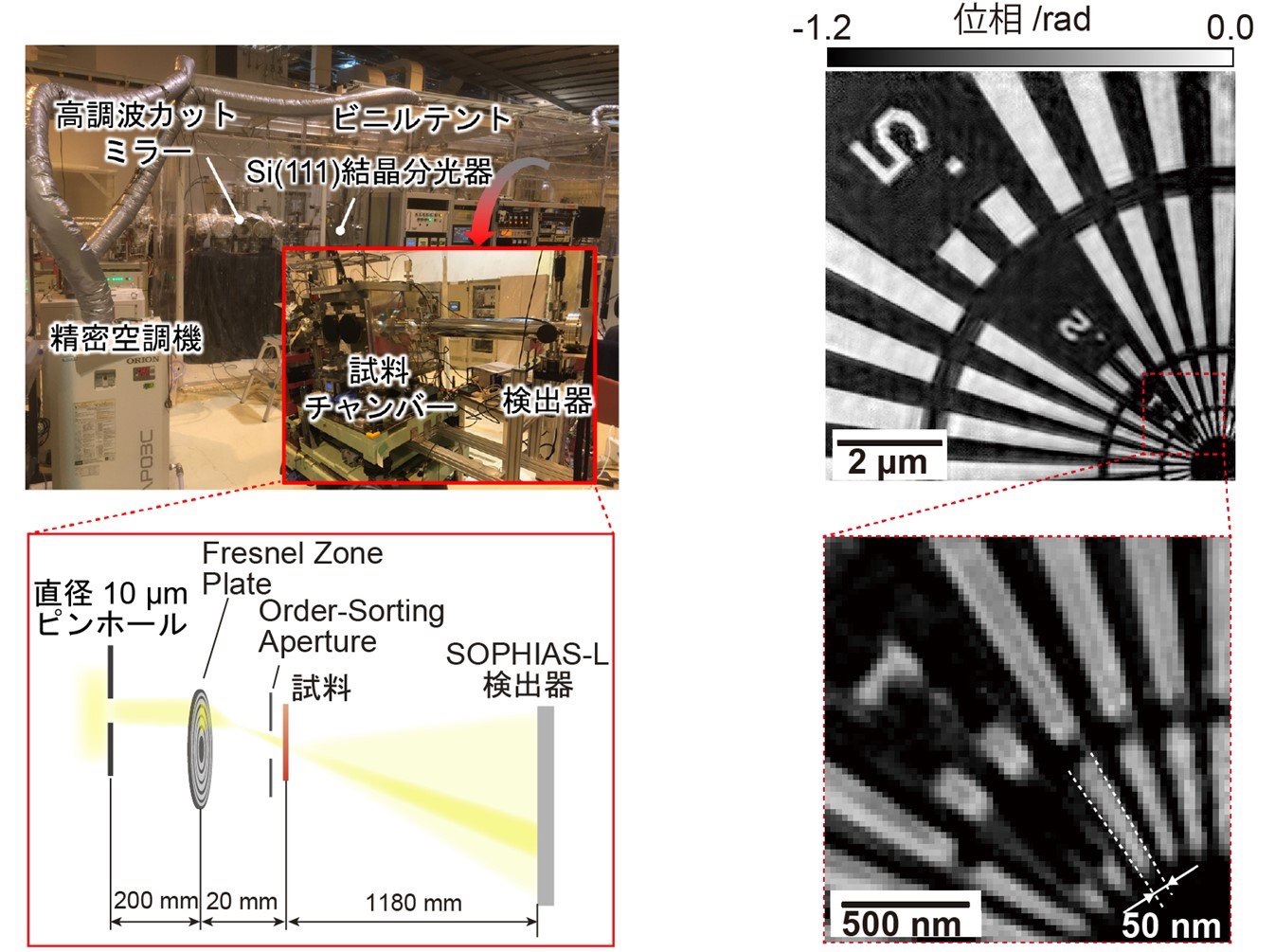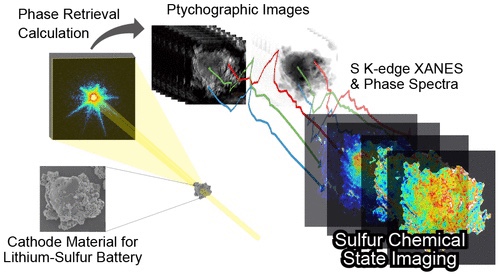

SPring8: Visualization of sulfur for batteries!
-Advance to Elucidation of Reaction and Deterioration Mechanisms of Lithium-Sulfur Batteries-
Sumitomo Rubber
Tohoku University International Synchrotron Radiation Research Center,
RIKEN,
Synchrotron Radiation Research Center
Succeeded in “visualization of lithium-sulfur batteries” using the world’s first high-precision measurement technology.
Visualization of “battery sulfur”:
By applying this technology, we will elucidate the LIB reaction/degradation mechanism.
In the future, the technology will also be applied to tire research, leading to the development of high-performance tires.
Sumitomo Rubber:
The knowledge cultivated in tire research was applied to the field of LIB.
In 2011, in collaboration with the National Institute of Advanced Industrial Science and Technology, we have been promoting “research and development of lithium-sulfur batteries.”
Lithium-sulfur battery:
Lithium-sulphur batteries are
The theoretical capacity is expected to be 6 to 7 times that of LIB, and it is lightweight and safe.
Charge/discharge cycle life:
However, “the cycle life of charging and discharging” is a problem.
In order to improve the cycle life, it is necessary to measure sulfur compounds with high accuracy.
Large synchrotron radiation facility: “SPring-8”
The research group
“Large-scale synchrotron radiation facility that can use tender X-rays with uniform X-ray waves”
Utilized “SPring-8”.
Established the “tender X-ray nanoscope” for the first time.
With this measurement technology,
Succeeded in “visualizing sulfur compounds at the nano level”.
Visualization of sulfur compounds:
Next-generation synchrotron radiation facility scheduled to start operation in 2024
“NanoTerasu” will also be used.
We will work on “measurement under the operating environment of lithium-sulfur batteries” and “early commercialization of material development.”
response
https://response.jp/article/2022/09/06/361444.html
Establishment of measurement technology that captures the chemical state of sulfur with a high resolution of 50 nanometers -Expectations for elucidation of the reaction and deterioration mechanism of lithium-sulfur batteries-
http://www.tohoku.ac.jp/japanese/newimg/pressimg/tohokuuniv-press20220905_02web_sulfur.pdf
SPring8 : Visualisation du soufre pour les batteries !
-Avancement vers l’élucidation des mécanismes de réaction et de détérioration des batteries lithium-soufre-
Caoutchouc Sumitomo
Centre international de recherche sur le rayonnement synchrotron de l’Université de Tohoku,
RIKEN,
Centre de recherche sur le rayonnement synchrotron
A réussi la “visualisation des batteries lithium-soufre” en utilisant la première technologie de mesure de haute précision au monde.
Visualisation du “soufre de batterie”:
En appliquant cette technologie, nous allons élucider le mécanisme de réaction/dégradation du LIB.
À l’avenir, la technologie sera également appliquée à la recherche sur les pneus, menant au développement de pneus hautes performances.
Caoutchouc Sumitomo :
Les connaissances cultivées dans la recherche sur les pneus ont été appliquées au domaine du LIB.
En 2011, en collaboration avec l’Institut national des sciences et technologies industrielles avancées, nous avons promu « la recherche et le développement des batteries lithium-soufre ».
Batterie au lithium-soufre :
Les batteries au lithium-soufre sont
La capacité théorique devrait être de 6 à 7 fois supérieure à celle du LIB, et il est léger et sûr.
Durée de vie du cycle de charge/décharge :
Cependant, “la durée de vie du cycle de charge et de décharge” est un problème.
Afin d’améliorer la durée de vie du cycle, il est nécessaire de mesurer les composés soufrés avec une grande précision.
Grande installation de rayonnement synchrotron : “SPring-8”
Le groupe de recherche
“Installation de rayonnement synchrotron à grande échelle pouvant utiliser des rayons X tendres avec des ondes de rayons X uniformes”
Utilisé “SPring-8”.
Création du “nanoscope tendre à rayons X” pour la première fois.
Grâce à cette technologie de mesure,
Réussi à “visualiser les composés soufrés au niveau nano”.
Visualisation des composés soufrés :
Installation de rayonnement synchrotron de nouvelle génération dont la mise en service est prévue en 2024
“NanoTerasu” sera également utilisé.
Nous travaillerons sur “la mesure dans l’environnement de fonctionnement des batteries lithium-soufre” et “la commercialisation précoce du développement de matériaux”.
réponse
Mise en place d’une technologie de mesure qui capture l’état chimique du soufre avec une haute résolution de 50 nanomètres -Attentes pour l’élucidation du mécanisme de réaction et de détérioration des batteries lithium-soufre-
SPring8: Visualisierung von Schwefel für Batterien!
-Fortschritte zur Aufklärung von Reaktions- und Alterungsmechanismen von Lithium-Schwefel-Batterien-
Sumitomo-Gummi
Internationales Forschungszentrum für Synchrotronstrahlung der Universität Tohoku,
RIKEN,
Forschungszentrum für Synchrotronstrahlung
Erfolgreiche „Visualisierung von Lithium-Schwefel-Batterien“ mit der weltweit ersten hochpräzisen Messtechnik.
Visualisierung „Batterieschwefel“:
Durch Anwendung dieser Technologie werden wir den LIB-Reaktions-/Abbaumechanismus aufklären.
Künftig soll die Technologie auch in der Reifenforschung Anwendung finden und zur Entwicklung von Hochleistungsreifen führen.
Sumitomo-Gummi:
Das in der Reifenforschung kultivierte Wissen wurde auf das Gebiet der LIB übertragen.
2011 haben wir in Zusammenarbeit mit dem National Institute of Advanced Industrial Science and Technology die „Forschung und Entwicklung von Lithium-Schwefel-Batterien“ vorangetrieben.
Lithium-Schwefel-Batterie:
Lithium-Schwefel-Batterien sind
Die theoretische Kapazität wird voraussichtlich das 6- bis 7-fache der von LIB betragen, und es ist leicht und sicher.
Lebensdauer des Lade-/Entladezyklus:
Jedoch ist “die Zykluslebensdauer des Ladens und Entladens” ein Problem.
Um die Zykluslebensdauer zu verbessern, ist es notwendig, Schwefelverbindungen mit hoher Genauigkeit zu messen.
Große Synchrotronstrahlungsanlage: „SPring-8“
Die Forschungsgruppe
“Große Synchrotron-Strahlungsanlage, die zarte Röntgenstrahlen mit gleichmäßigen Röntgenwellen verwenden kann”
Verwendet “SPring-8”.
Etablierte erstmals das „Tender X-ray Nanoscope“.
Mit dieser Messtechnik
Erfolgreiche „Visualisierung von Schwefelverbindungen auf Nanoebene“.
Visualisierung von Schwefelverbindungen:
Synchrotronstrahlungsanlage der nächsten Generation soll 2024 in Betrieb gehen
Auch “NanoTerasu” wird zum Einsatz kommen.
Wir werden uns mit der „Messung unter der Betriebsumgebung von Lithium-Schwefel-Batterien“ und der „frühen Kommerzialisierung der Materialentwicklung“ befassen.
Antwort
Etablierung einer Messtechnik, die den chemischen Zustand von Schwefel mit einer hohen Auflösung von 50 Nanometern erfasst -Erwartungen zur Aufklärung des Reaktions- und Alterungsmechanismus von Lithium-Schwefel-Batterien-
Visualization of Sulfur Chemical State of Cathode Active Materials for Lithium–Sulfur Batteries by Tender X-ray Spectroscopic Ptychography
The Journal of Physical Chemistry
Abstract
Lithium–Sulfur batteries are rechargeable batteries
that have attracted much attention in recent years because of their large theoretical capacity and the low cost of sulfur.
However,
there is an obstacle to the development of cathode materials for practical use:
the reaction and degradation mechanisms during the charge–discharge process are not fully understood.
In this study, we demonstrated
the visualization of the sulfur chemical state of cathode active materials at a high spatial resolution using tender X-ray spectroscopic ptychography.
We measured the sulfurized poly(n-butyl methacrylate) (SPBMA) samples
in the form of particles and small pieces of cathode composites at the S K-edge (∼2.47 keV)
and successfully visualized the heterogeneous distribution of sulfur chemical state parameters and their trend changes by the charge/discharge processes in them.
We found that the distribution of sulfur chemical states in SPBMA particles
is heterogeneous and that traces of the discharge reaction exist near the particle surface.
We also found that the cathode composites accumulated sulfur oxides, possibly due to side reactions between sulfur and the electrolyte.